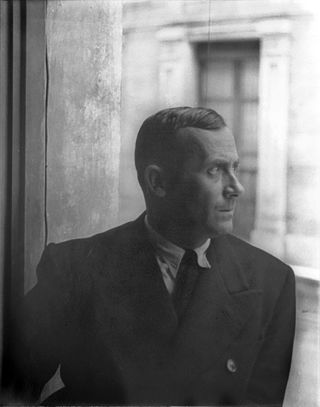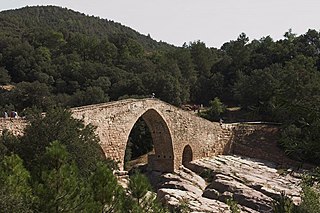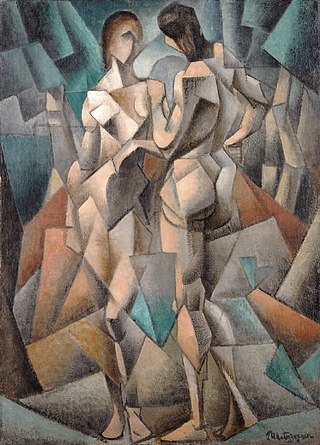
Joan Miró i Ferrà was a Catalan Spanish painter, sculptor and ceramist. A museum dedicated to his work, the Fundació Joan Miró, was established in his native city of Barcelona in 1975, and another, the Fundació Pilar i Joan Miró, was established in his adoptive city of Palma in 1981.

Joaquín Torres-García was a prominent Uruguayan-Spanish artist, theorist, and author, renowned for his international impact in the modern art world. Born in Montevideo, Uruguay, his family moved to Catalonia, Spain, where his artistic journey began. His career spanned several countries including Spain, New York, Italy, France, and Uruguay. A founder of art schools and groups, he notably established the first European abstract-art group, Cercle et Carré, in Paris in 1929 which included Piet Mondrian and Kandinsky. Torres-García's legacy is deeply rooted in his development of Modern Classicism and Universal Constructivism.

The Museu Nacional d'Art de Catalunya, abbreviated as MNAC, is a museum of Catalan visual art located in Barcelona, Catalonia, Spain. Situated on Montjuïc hill at the end of Avinguda de la Reina Maria Cristina, near Pl Espanya, the museum is especially notable for its outstanding collection of romanesque church paintings, and for Catalan art and design from the late 19th and early 20th centuries, including modernisme and noucentisme. The museum is housed in the Palau Nacional, a huge, Italian-style building dating to 1929. The Palau Nacional, which has housed the Museu d'Art de Catalunya since 1934, was declared a national museum in 1990 under the Museums Law passed by the Catalan Government. That same year, a thorough renovation process was launched to refurbish the site, based on plans drawn up by the architects Gae Aulenti and Enric Steegmann, who were later joined in the undertaking by Josep Benedito. The Oval Hall was reopened for the 1992 Summer Olympic Games, and the various collections were installed and opened over the period from 1995 to 2004. The museum was officially inaugurated on 16 December 2004. It is one of the largest museums in Spain.

The Fundació Joan Miró is a modern art museum honoring the life and work of the Spanish artist Joan Miró, located on the hill called Montjuïc in Barcelona, Catalonia (Spain).

Vilafranca del Penedès, or simply Vilafranca, is the capital of Alt Penedès county in Penedès, Catalonia, Spain. It is situated in the Penedès Depression on the left bank of the Foix River, and on the main axis of communication from Barcelona to Tarragona and Valencia, served by a Rodalies Barcelona line 4 and by the AP-7 autopista as well as by the C-243 towards Sant Sadurní d'Anoia, and C-15 roads to Vilanova i la Geltrú and Igualada respectively.

Cercs is a municipality in the comarca of Berguedà in Catalonia. It is situated on the right bank of the Llobregat river above the Baells reservoir. It is the site of an important power station which burns the lignite extracted at Fígols and Saldes. The town is served by the C-1411 road between Berga and the Cadí tunnel.

Barcelona'sculture stems from the city's 2000 years of history. Barcelona has historically been a cultural center of reference in the world. To a greater extent than the rest of Catalonia, where Catalonia's native language Catalan is more dominant, Barcelona is a bilingual city: Catalan and Spanish are both official and widely spoken. Since the arrival of democracy, the Catalan culture has experienced a rebirth, both by recovering works from the past and by stimulating the creation of new works. Barcelona is an international hub of highly active and diverse cultural life with theatres, concert halls, cinemas, museums, and high-value architectural heritage.

Josep Domènech i Estapà was a Catalan architect.

Josep Guinovart i Bertran was a Spanish painter best known for his informalist or abstract expressionist work.

Albert Ràfols-Casamada was a Spanish painter, poet and art teacher involved in the vanguard movements of his time. He is considered one of the most important, multifaceted Catalan artists of his time. His artwork began in the post-expressionist, figurative sphere but soon developed into his own abstract style grounded in a poetic rendering of everyday reality.

Eduard Arranz Bravo was a Catalan Spanish painter.
Antoni Vila Arrufat (1894–1989) was a Spanish engraver from Sabadell in Catalonia.

Desolation is a sculpture that was crafted by Josep Llimona in 1907, which now resides in the National Art Museum of Catalonia in Barcelona.

Terraced Village is a painting by Joaquim Mir currently exhibited at the National Art Museum of Catalonia.

Alfons Borrell i Palazón was a Spanish abstract painter.
Carles Delclaux Is is a textile artist trained in the Aymat factory and in the Massana School of Fine Arts in Barcelona.

Francesc Fontbona de Vallescar is a Catalan art historian, writer, exhibition curator and specialist in Romanticism, Catalan Modernism and Noucentisme Arts. Fontbona is the author of many works of Catalan art history. Doctorate in Early modern period from the Universitat de Barcelona in 1987. He was director of Graphic section in National Library of Catalonia (1995-2013), and Chief executive-writer of art section in the Great Catalan Encyclopedia (1968–78). Francesc Fontbona is member of the Royal Catalan Academy of Fine Arts of Saint George, member of The Hispanic Society of America, member of the Institut d’Estudis Catalans and Board chair of the Institut Amatller d'Art Hispànic.

Galeries Dalmau was an art gallery in Barcelona, Spain, from 1906 to 1930. The gallery was founded and managed by the Symbolist painter and restorer Josep Dalmau i Rafel. The aim was to promote, import and export avant-garde artistic talent. Dalmau is credited for having launched avant-garde art in Spain.

The following outline is provided as an overview of and topical guide to Barcelona:
The Tapestry of the Fundació is a tapestry made by Joan Miró and Josep Royo in 1979 and that is conserved in the Fundació Joan Miró, in Barcelona.

















